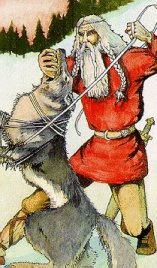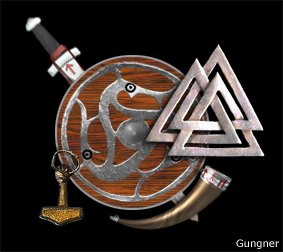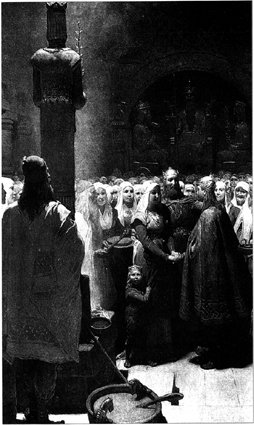
Lord Tyr, Sky God, War God, God of the North
Who art thou, Lord Tyr?
Sky God
War God
Tyr
Tiw
Tiwaz
Teiva
Ziu
Zio
Husband of Isis?
God of the Lefthand Path
He who giveth his right hand for the salvation of the world


“Tyr is considered one of the oldest of the Gods. His name can be traced back to the original Indo-European Sky Father Dyevs, the Shining One. He has been associated with Dyaus, Zeus and Jove. Its believed he once held the top position among the ancient pantheon…” – excerpt from http://www.balderrising.org/tyr.htm
Much later Tyr was relegated to a minor role with Odin taking top position. Lord Tyr actually pre-dates Odin and was the original All-Father of Gods and Men. His symbol was the spear, (a symbol now use by Odin) the Rune named for Tyr is the shape of a spear. He was one of the gods who had a day of the week set aside to honor him. Tuesday — Tiw’s-Day is that day.
Oldest European God, his name has been found inscribed (in Runes) on swords, shields and helmets, the most ancient of which is the Negau helmet found in Austria near the Yugoslav border in 1929 dating amazingly to 600 BC. The inscription is written in ancient North Italic letters which are very similar to runes. It says “Harixasti Teiva” which is usually translated as, “to the Army-Guest (host) the god Teiwaz.”* Teiva and Teiwaz are spellings of Tyr. His original name was spelled and pronounced Tiw which rhymes with ewe, or the sound at the beginning of the word Tuesday. But the Scandinavians put an “R” on the end of almost every name, so his name evolved into Tyr. The germanic languages often added -az to the end, thus the Tiwaz and Teivaz and other variant spellings. Translators sometimes spell Harixasti with a “g” as Harigasti. It means “Army-Guest” as though the wearer of the helmet invited the god Teiva into his own body (as a “guest”) to lead the army and win the battle. Scholars date the inscription to somewhere between 600 BC and 200 BC.
*Citation: In Search of the Indo-Europeans, by J.P. Mallory, 1989, p.85
Wikipedia says
this about Lord Tyr:
Scholars believe that he was the original chief god, the Germanic equivalent of the Greek Zeus, who was later overtaken in popularity and therefore in authority by Odin. He was known for his courage: at one stage the gods decided to shackle the wolf Fenrir (also called Fenris wolf), but the beast broke every chain they put upon him. Eventually they had the dwarves make them a magical ribbon (called Gleipnir)… But Fenrir sensed the gods’ deceit and refused to be bound with it unless one of them put his hand in the wolf’s mouth. This, we are told, is how Fenrir was bound until the day of Ragnarok and how Tyr lost his hand.
During Ragnarok, Tyr is destined to kill and be killed by Garm, the guard dog of Helheim (Hell).
Tuesday is named for Tyr (in Old English, Tiw).
Alternative: Tiw (Old English), Ziu, Tiwaz, Teiva, Zio

Alfta says on her Intro to Heithni (heathenism):
Tyr is the cheiftain of the warrior class. His name means simply, “god,” and just like the rune Tivaz (Tiwaz, Tyr rune), it also means “victory.” He is known by some as Odin’s brother. His duty is as a living example of honour, defense of kin and property, nobleness of nature and right striving. His most famous weapon is the sword, and the shield. Some say he trains the Aesir (northern gods) from youth in the martial arts.
Tyr cared for the pup Fenrir, whose name means “marsh-dweller,” when no one else could train him.
[Katia interjects: because he was an element of chaos with the potential to turn evil and prophesied to kill the All-Father some day at Ragnarock, the Northern term for Armageddon. Only Tyr could handle this raw chaos and recognizing that even the wolf Fenrir comes from the Holy Creator, Tyr treated the pup honorably. The story is reminiscent of the way Satan was treated in Heaven by the Christian All-Father.]
And when Fenrir became mature, and so wild [and the prophecy he might destroy the gods became known] everyone decided to bind him up. Tyr gave his hand to Fenrir for having had to deceive him into being bound. There is another canine, a dog named Garm, whose name means “rag,” that watches the maingate into Hel who has sworn Tyr an enemy.
![]()
For more on this fascinating ancient deity:
Visit his Harrow: Click here and then go to the bottom left corner of the “temple arches” and click on TYR’s name. Once there you will find beautiful verses from northern “scriptures” to Lord Tyr as well as a place where you can post an “offering” to him and read the other offerings posted by others.
Here is an entire website dedicated to Lord Tyr.
Tyr Devotional &
Research Site
LESSON QUESTIONS
Please read all the articles and information above on Lord Tyr, then answer the following questions. Send them to the
Mystery School with the subject line: Lord Tyr Answers from _____ (your magikal name).
1) What did Tyr give “for the salvation of the world”?
2) T/F – Odin pre-dates Tyr as the All-Father.
3) Which day of the week was set aside to honor Tyr?
4) What is Tyr’s ultimate destiny, according to Teutonic mythology?
5) What does Tyr’s name mean?
6) Which class of people is Tyr the chieftain of?
7) Why did Tyr spare Fenrir?
8) Critical thinking: What does Tyr mean to modern-day Heathens? Why is he an important god in our day and age?

